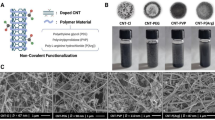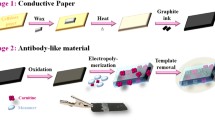Abstract
An electrochemical paper-based sensor was developed for the detection of bacterial infection (BI)-specific biomarker procalcitonin (PCT). Reduced graphene oxide-gold nanoparticles (rGO-AuNP) and poly(3,4-ethylene dioxythiophene):poly(styrene sulfonate) (PEDOT:PSS) were synthesized and were fabricated to a disposable, portable, and inexpensive cellulose fiber paper (CFP) substrate. rGO-AuNP-PEDOT:PSS nanocomposite-modified conductive paper-based biosensing platform was efficaciously fabricated by a constant and simple coating procedure. rGO-AuNP-PEDOT:PSS nanocomposite-modified conductive paper electrode was found to provide a sensitive and conductive substrate for PCT detection. The presence of rGO-AuNP-PEDOT:PSS nanocomposite on CFP substate was investigated by Fourier transform infrared spectrometry, field emission scanning electron microscopy, ultraviolet–visible spectroscopy, and X-ray diffraction studies. The electrochemical behavior of rGO-AuNP-PEDOT:PSS @CFP surface was studied with impedance spectroscopy, cyclic voltammetry, and chronoamperometry techniques. This low-cost paper-based biosensor has a linear range for PCT of 1 × 103 to 6 × 107 fg mL−1. This developed sensor exhibited good reproducibility with a relative standard deviation (RSD) of about 3.7%. The proposed CFP-based biosensor has been proven as an accelerated simple point-of-care (POC) exploratory approach for early PCT diagnosis in inadequate areas with limited production facilities, computational techniques, and highly skilled experts.
Graphical Abstract







Similar content being viewed by others
Data Availability
All data is available within the manuscript.
References
Gupta, Y. and A.S. Ghrera (2021) Recent advances in gold nanoparticle-based lateral flow immunoassay for the detection of bacterial infection. Archi.Micro biol. 3767-3784. https://doi.org/10.1007/s00203-021-02357-9
Joseph P, Godofsky E (2018) Outpatient antibiotic stewardship: a growing frontier—combining myxovirus resistance protein A with other biomarkers to improve antibiotic use. Open Forum Infect Dis 5(2):024. https://doi.org/10.1093/ofid/ofy024
Vijayan AL, Vanimaya R, Shilpa S, R., Lakshmi, S., Kartik, R., & G, Manoj, (2017) Procalcitonin: a promising diagnostic marker for sepsis and antibiotic therapy. J Intensive Care 5(1):51. https://doi.org/10.1186/s40560-017-0246-8
Naresh, Varnakavi, & Lee, Nohyun (2021) A review on biosensors and recent development of nanostructured materials-enabled biosensors. Sensors, (4). https://doi.org/10.3390/s21041109
Naghdi, Samira, Rhee, Kyong Y., Hui, David, & Park, Soo J. (2018) A review of conductive metal nanomaterials as conductive, transparent, and flexible coatings, thin films, and conductive fillers: different deposition methods and applications. Coatings, 8(8). https://doi.org/10.3390/coatings8080278.
Ghrera AS (2019) Quantum dot modified interface for electrochemical immunosensing of procalcitonin for the detection of urinary tract infection. Anal Chimi Acta 1056:26–33. https://doi.org/10.1016/j.aca.2018.12.047
Song X, Yu S, Zhao L, Guo Y, Ren X, Ma H, Wang S, Luo C, Li Y, Wei Q (2022) Efficient ABEI-dissolved O2-Ce(III, IV)-MOF ternary electrochemiluminescent system combined with self-assembled microfluidic chips for bioanalysis. Anal. Chem. 949363-9371. https://doi.org/10.1021/acs.analchem.2c01199
Yue Q, Li X, Xu X, Huang X, Cao D, Wei Q, Cao W (2022) Ratiometric electrochemical immunoassay for procalcitonin based on dual signal probes: Ag NPs and Nile blue A. Microchim Acta 1(189):126. https://doi.org/10.1007/s00604-022-05225-5
Ge XY, Zhang JX, Feng YG, Wang AJ, Mei LP, Feng JJ (2022) Label-free electrochemical biosensor for determination of procalcitonin based on graphene-wrapped Co nanoparticles encapsulated in carbon nanobrushes coupled with AuPtCu nanodendrites. Mikrochim Acta 189:110. https://doi.org/10.1007/s00604-022-05179-8
Ghrera AS, Pandey CM, Malhotra BD (2018) Multiwalled carbon nanotube modified microfluidic-based biosensor chip for nucleic acid detection. Sens Actuators B: Chem 266:329–336. https://doi.org/10.1016/j.snb.2018.03.118
Lakard, Boris (2020) Electrochemical biosensors based on conducting polymers: a review. App Sci 10 (18). https://doi.org/10.3390/app10186614
Zaidi SA, Shin JH (2016) Recent developments in nanostructure based electrochemical glucose sensors. Talanta 149:30–42. https://doi.org/10.1016/j.talanta.2015.11.033
Nasir, Salisu, Hussein, Mohd Z., Zainal, Zulkarnain, & Yusof, Nor A (2018). Carbon-based nanomaterials/allotropes: a glimpse of their synthesis, properties and some applications. Materials, 11(2). https://doi.org/10.3390/ma11020295
Leng J, Wang Z, Wang J, Wu H-H, Yan G, Li X, Guo Z (2019) Advances in nanostructures fabricated via spray pyrolysis and their applications in energy storage and conversion. Chemi Soc Rev 48(11):3015–3072. https://doi.org/10.1039/C8CS00904J
Xiao T, Huang J, Wang D, Meng T, Yang X (2020) Au and Au-based nanomaterials: synthesis and recent progress in electrochemical sensor applications. Talanta 206:120210. https://doi.org/10.1016/j.talanta.2019.120210
Gupta Y, Ghrera AS (2022) Disposable paper-based biosensing platform for procalcitonin detection. Anal Bioanal Chem Res 10:15–23. https://doi.org/10.22036/ABCR.2022.340432.1761
Gao, Yan-Sha, Xu, Jing-Kun, Lu, Li-Min, Zhu, Xiao-Fei, Wang, Wen-Min, Yang, Tao-Tao, Yu, Yong-Fang (2015) A label-free electrochemical immunosensor for carcinoembryonic antigen detection on a graphene platform doped with poly(3,4-ethylenedioxythiophene)/Au nanoparticles. RSC Advances 86910-86918. https://doi.org/10.1039/C5RA16618G
Saeed AA, Sánchez JL, Acero O, Ciara K, Abbas MN (2017) DNA biosensors based on gold nanoparticles-modified graphene oxide for the detection of breast cancer biomarkers for early diagnosis. Bioelectrochemistry 118:91–99. https://doi.org/10.1016/j.bioelechem.2017.07.002
Zaaba NI, Foo KL, Hashim U, Tan SJ, Liu W-W, Voon CH (2017) Synthesis of graphene oxide using modified Hummers method: solvent influence. Procedia Engineering 184:469–477. https://doi.org/10.1016/j.proeng.2017.04.118
Paul G, Verma S, Jalil O, Thakur D, Pandey CM, Kumar D (2021) PEDOT: PSS-grafted graphene oxide-titanium dioxide nanohybrid-based conducting paper for glucose detection. Polym Adv Technol 32(4):1774–1782. https://doi.org/10.1002/pat.5213
Gupta Y, Sharma A (2021) Electrochemical studies of lateral flow assay test results for procalcitonin detection. J Elec Sci and Engi. https://doi.org/10.5599/jese.1127
Turkevich J, Stevenson PC, Hillier J (1951) A study of the nucleation and growth processes in the synthesis of colloidal gold. Discuss Faraday Soc 11:55–75. https://doi.org/10.1039/DF9511100055
Dong Jiaqi, Carpinone Paul L, Pyrgiotakis Georgios, Demokritou Philip, Moudgil Brij M (2020) Synthesis of precision gold nanoparticles using Turkevich method. Kona 37:224–232. https://doi.org/10.14356/kona.2020011
Suchomel P, Kvitek L, Prucek R, Panacek A, Halder A, Vajda S, Zboril R (2018) Simple size-controlled synthesis of Au nanoparticles and their size-dependent catalytic activity. Sci Rep 8(1):4589. https://doi.org/10.1038/s41598-018-22976-5
Gu C-J, Kong F-Y, Chen Z-D, Fan D-H, Fang H-L, Wang W (2016) Reduced graphene oxide-Hemin-Au nanohybrids: facile one-pot synthesis and enhanced electrocatalytic activity towards the reduction of hydrogen peroxide. Biosesn Bioelectron 78:300–307. https://doi.org/10.1016/j.bios.2015.11.035
Lee SJ, Kim J-Y, Yusoff M, Rashid A, bin, & Jang, Jin, (2015) Plasmonic organic solar cell employing Au NP:PEDOT:PSS doped rGO. RSC Adv 5(30):23892–23899. https://doi.org/10.1039/C5RA02878G
Bose S, Kuila T, Mishra AK, Kim NH, Lee JH (2012) Dual role of glycine as a chemical functionalizer and a reducing agent in the preparation of graphene: an environmentally friendly method. J Mater Chem 22(2019):9696–9703. https://doi.org/10.1039/C2JM00011C
Yoo D, Kim J, Kim JH (2014) Direct synthesis of highly conductive poly(3,4-ethylenedioxythiophene):poly(4-styrenesulfonate) (PEDOT:PSS)/graphene composites and their applications in energy harvesting systems. Nano Res 7(5):717–730. https://doi.org/10.1007/s12274-014-0433-z
Zhou H, Yao W, Li G, Wang J, Lu Y (2013) Graphene/poly(3,4-ethylenedioxythiophene) hydrogel with excellent mechanical performance and high conductivity. Carbon 59:495–502. https://doi.org/10.1016/j.carbon.2013.03.045
Yang W, Zhao Y, He X, Chen Y, Xu J, Li S, Jiang Y (2015) Flexible conducting polymer/reduced graphene oxide films: synthesis, characterization, and electrochemical performance. Nanoscale Res Lett 10(1):222. https://doi.org/10.1186/s11671-015-0932-1
Pananon P, Sriprachuabwong C, Wisitsoraat A, Chuysinuan P, Tuantranont A, Saparpakorn P, Dechtrirat D (2018) A facile one-pot green synthesis of gold nanoparticle-graphene-PEDOT:PSS nanocomposite for selective electrochemical detection of dopamine. RSC Adv 8(2018):12724–12732. https://doi.org/10.1039/C8RA01564C
Krishnamurthy S, Esterle A, Sharma NC et al (2014) Yucca-derived synthesis of gold nanomaterial and their catalytic potential. Nanoscale Res Lett 9:627. https://doi.org/10.1186/1556-276X-9-627
Mercante LA, Facure MHM, Sanfelice RC, Migliorini FL, Mattoso LHC, Correa DS (2017) One-pot preparation of PEDOT:PSS-reduced graphene decorated with Au nanoparticles for enzymatic electrochemical sensing of H2O2. Appl Sur Sci 407:162–170. https://doi.org/10.1016/j.apsusc.2017.02.156
Narang J, Malhotra N, Singhal C, Mathur A, Chakraborty D, Anil A, Pundir CS (2017) Point of care with micro fluidic paper based device integrated with nano zeolite–graphene oxide nanoflakes for electrochemical sensing of ketamine. Biosen Bioelectron 88:249–257. https://doi.org/10.1016/j.bios.2016.08.043
Ruecha R, Nipapan S, Kwanwoo C, Orawon, & Rodthongkum, Nadnudda, (2019) Label-free paper-based electrochemical impedance immunosensor for human interferon gamma detection. Sens Actuators B: Chem 279:298–304. https://doi.org/10.1016/j.snb.2018.10.024
Kumar S, Umar M, Saifi A, Kumar S, Augustine S, Srivastava S, Malhotra BD (2019) Electrochemical paper based cancer biosensor using iron oxide nanoparticles decorated PEDOT:PSS. Anal Chimi Acta 1056:135–145. https://doi.org/10.1016/j.aca.2018.12.053
Okuno J, Maehashi K, Kerman K, Takamura Y, Matsumoto K, Tamiya E (2007) Label-free immunosensor for prostate-specific antigen based on single-walled carbon nanotube array-modified microelectrodes. Biosens Bioelectr 22(2007):2377–2381. https://doi.org/10.1016/j.bios.2010.09.038
Srivastava S, Vinod Kumar Md, Ali A, Solanki PR, Srivastava A, Sumana G, Saxena PS, Joshi AG, Malhotra BD (2013) Electrophoretically deposited reduced graphene oxide platform for food toxin detection. Nanoscale 5:3043–3051. https://doi.org/10.1039/C3NR32242D
Azahar Ali Md, Srivastava S, Agrawal VV, Willander M, John R, Malhotra BD (2016) A biofunctionalized quantum dot–nickel oxide nanorod based smart platform for lipid detection. J Mat Chem B 4:2706–2714. https://doi.org/10.1039/C5TB02578H
Singh R, Hong S, Jang J (2017) Label-free detection of influenza viruses using a reduced graphene oxide-based electrochemical immunosensor integrated with a microfluidic platform. Sci Rep 7(2017):42771. https://doi.org/10.1038/srep42771
Bhardwaj J, Devarakonda S, Kumar S, Jang J (2017) Development of a paper-based electrochemical immunosensor using an antibody-single walled carbon nanotubes bio-conjugate modified electrode for label-free detection of foodborne pathogens. Sens Actuat B: Chem 253:115–123. https://doi.org/10.1016/j.snb.2017.06.108
Chauhan D, Solanki PR (2019) Hydrophilic and insoluble electrospun cellulose acetate fiber-based biosensing Ppatform for 25-hydroxy vitamin-D3 detection. ACS App Poly Mate 1(7):1613–1623. https://doi.org/10.1021/acsapm.9b00179
Boonkaew Suchanat, Jang Ilhoon, Noviana Eka, Siangproh Weena, Chailapakul Orawon, Henry Charles S (2021) Electrochemical paper-based analytical device for multiplexed, point-of-care detection of cardiovascular disease biomarkers. Sens Actuators B Chem 330:129336. https://doi.org/10.1016/j.snb.2020.129336
Romanholo PVV, Razzino CA, Raymundo-Pereira PA, Prado TM, Machado SAS, Sgobbi LF (2021) Biomimetic electrochemical sensors: new horizons and challenges in biosensing applications. Biosens Bioelectron 185:113242. https://doi.org/10.1016/j.bios.2021.113242
Sahu S, Dutta G (2021) Emerging evidence for serum procalcitonin estimation at point-of-care and advancement in quantitative sensing strategies over the past decade. Sensors Int 2:100107. https://doi.org/10.1016/j.sintl.2021.100107
Meisner M (2002) Pathobiochemistry and clinical use of procalcitonin. Clin Chim Acta 23:17–29. https://doi.org/10.1016/S0009-8981(02)00101-8
Liu F, Xiang G, Yuan R, Chen X, Luo F, Jiang D, Huang S, Li Y, Pu X (2014) Procalcitonin sensitive detection based on graphene-gold nanocomposite film sensor platform and single-walled carbon nanohorns/hollow Pt chains complex as signal tags. Biosens Bioelectron. 60 0-7. https://doi.org/10.1016/j.bios.2014.03.071
Yang L, Xue J, Jia Y, Zhang Y, Wu D, Ma H, Wei Q, Ju H (2019) Construction of well-ordered electrochemiluminescence sensing interface using peptide-based specific antibody immobilizer and N-(aminobutyl)-N-(ethylisoluminol) functionalized ferritin as signal indicator for procalcitonin analysis. Biosens Bioelectron 142:111562. https://doi.org/10.1016/j.bios.2019.111562
Fang YS, Wang HY, Wang LS, Wang JF (2014) Electrochemical immunoassay for procalcitonin antigen detection based on signal amplification strategy of multiple nanocomposites. Biosens Bioelectron. 51310-6. https://doi.org/10.1016/j.bios.2013.07.035
Liu P, Li C, Zhang R, Tang Q, Wei J, Lu Y, Shen P (2019) An ultrasensitive electrochemical immunosensor for procalcitonin detection based on the gold nanoparticles-enhanced tyramide signal amplification strategy. Biosens Bioelectron 126:543–550. https://doi.org/10.1016/j.bios.2018.10.048
Acknowledgements
The authors acknowledge the support from Manipal University for the FESEM, EDX, FT-IR, and UV analysis and acknowledge Delhi Technological University for electrical conductivity measurements.
Funding
A. S. Ghrera thanks financial support received from Science and Engineering Board (DST), India under the Young Scientist project (YSS/2015/001330).
Author information
Authors and Affiliations
Corresponding author
Ethics declarations
Conflict of interest
The authors declare no competing interests.
Additional information
Publisher's note
Springer Nature remains neutral with regard to jurisdictional claims in published maps and institutional affiliations.
Rights and permissions
Springer Nature or its licensor (e.g. a society or other partner) holds exclusive rights to this article under a publishing agreement with the author(s) or other rightsholder(s); author self-archiving of the accepted manuscript version of this article is solely governed by the terms of such publishing agreement and applicable law.
About this article
Cite this article
Gupta, Y., Pandey, C.M. & Ghrera, A.S. Development of conducting cellulose paper for electrochemical sensing of procalcitonin. Microchim Acta 190, 32 (2023). https://doi.org/10.1007/s00604-022-05596-9
Received:
Accepted:
Published:
DOI: https://doi.org/10.1007/s00604-022-05596-9




